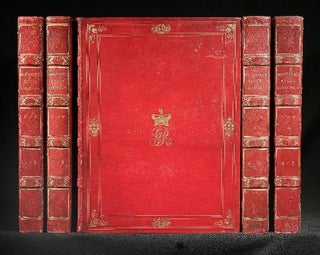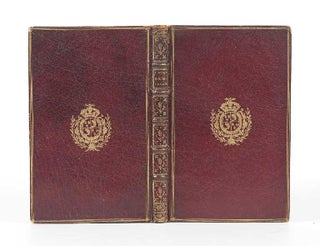An Unrecorded Moveable Type Edition
Daihokoengaku ryakusho chugyo 大方廣圓覺略疏注經; [Chinese title: Da fang guang yuan jue lüe su zhu jing]; [Commentary on the Sutra of Perfect Enlightenment (The Yuanjuejing)].
Eight columns per page, 17 characters per column. Three sizes of type. 42; 41; 38; 40 folding leaves. Four vols. Large 8vo (280 x 195 mm.), orig. dark wrappers dyed with persimmon juice (shibubiki), new stitching. [Enryakuji Temple, Mount Hiei: mid-Kan’ei, ca. 1626-30].
An unrecorded moveable type edition of the commentary and subcommentary of Zongmi (780-841), on the Sutra of Perfect Enlightenment. This is a rare example of an Eizan-ban, a book printed with moveable type at the temples on Mount Hiei, outside of Kyoto, where Enryakuji Temple, one of the most important monasteries of Japan and the headquarters of the Tendai sect of Japanese Buddhism, is located. Printing began there in the 13th century. “There were few of these [printed books] in the medieval period, perhaps due to the dominance of Kyoto itself as a printing centre…Eizan printing came into its own on a large scale only from the end of the sixteenth century, with the introduction of movable-type printing. Typographic printing flourished at various temples on Hieizan from the Keicho to Kan’ei periods (1596-1644), and with the publication of Chinese works as well as Tendai scriptures, publication and distribution at Hieizan began to develop into the beginnings of a commercial enterprise.”–K.B. Gardner, “Centres of Printing in Medieval Japan: Late Heian to Early Edo Period,” reprinted in Brokaw & Kornicki, eds., The History of the Book in East Asia (2013), p. 450.
The writings of Dushun (557-640), Zhiyan (602-68), Fazang (643-712), and Zongmi are considered by many as the “crowning glory of Chinese thought… marking the maturation of a process by which the Chinese made Buddhism their own.”–Bowring, The Religious Traditions of Japan 500-1600, p. 104.
Zongmi was a Tang dynasty Buddhist scholar monk; he was the fifth patriarch of the Huayan school as well as a patriarch of the Heze lineage of Southern Chan. The Sutra of Perfect Enlightenment was the scripture that led Zongmi to enlightenment in 808; he resolved to prepare a commentary and subcommentary on the text, which he accomplished fifteen years later.
As stated above, this moveable type edition is unrecorded. Kawase, in his bibliography of Japanese moveable type editions, records another printing of this text, dated 1626, but with ten columns per page and 20 characters per column (Vol. I, p. 304). Sorimachi, in his amazing 40th anniversary catalogue of moveable type books, issued in 1972, describes what appears to be yet another moveable type printing of this text with the same number of columns and characters as the Kawase example but using three different sizes of type (they might be the same printing). It is described as four parts in two volumes (in their original bindings), printed in mid-Kan’ei (ca. 1630), and with a slightly different title. The NIJL records no moveable type editions and only the woodblock-printed Seihan edition of 1644.
On the printed title-labels of the second and fourth volume covers the title is given as Engaku ryakusho chu. The labels on Vols. I and III are no longer present.
As mentioned above, the wrappers have been dyed with persimmon juice, which serves a dual purpose: to strengthen the paper and act as an insect repellent. Nevertheless, the wrappers are somewhat wormed.
Each volume has some worming, but this set is in rather fresh and appealing condition.
Price: $17,500.00
Item ID: 6775

![Item ID: 6775 Daihokoengaku ryakusho chugyo 大方廣圓覺略疏注經; [Chinese title: Da fang guang yuan jue lüe su zhu jing]; [Commentary on the Sutra of Perfect Enlightenment (The Yuanjuejing)]. ZONGMI 宗密, in Japanese: Shumitsu or Sumitsu.](https://jonathanahill.cdn.bibliopolis.com/pictures/6775.jpg?width=768&height=1000&fit=bounds&auto=webp&v=1574699988)
![Daihokoengaku ryakusho chugyo 大方廣圓覺略疏注經; [Chinese title: Da fang guang yuan jue lüe su zhu jing]; [Commentary on the Sutra of Perfect Enlightenment (The Yuanjuejing)].](https://jonathanahill.cdn.bibliopolis.com/pictures/6775_2.jpg?width=320&height=427&fit=bounds&auto=webp&v=1686230468)
![Daihokoengaku ryakusho chugyo 大方廣圓覺略疏注經; [Chinese title: Da fang guang yuan jue lüe su zhu jing]; [Commentary on the Sutra of Perfect Enlightenment (The Yuanjuejing)].](https://jonathanahill.cdn.bibliopolis.com/pictures/6775_3.jpg?width=320&height=427&fit=bounds&auto=webp&v=1686230468)
![Daihokoengaku ryakusho chugyo 大方廣圓覺略疏注經; [Chinese title: Da fang guang yuan jue lüe su zhu jing]; [Commentary on the Sutra of Perfect Enlightenment (The Yuanjuejing)].](https://jonathanahill.cdn.bibliopolis.com/pictures/6775_4.jpg?width=320&height=427&fit=bounds&auto=webp&v=1686230468)

![Yija sŏngni sŏ [or] Yija seongni seo. I. 李珥 YI.](https://jonathanahill.cdn.bibliopolis.com/pictures/9650.jpg?width=320&height=427&fit=bounds&auto=webp&v=1698173610)
![Genji kokagami 源氏小鏡 [or] Genji mokuroku [A Little Mirror of the Tale. MURASAKI SHIKIBU.](https://jonathanahill.cdn.bibliopolis.com/pictures/6625.jpg?width=320&height=427&fit=bounds&auto=webp&v=1559334766)
